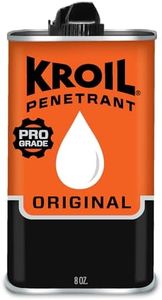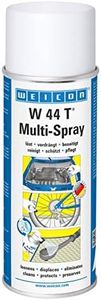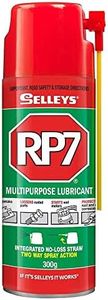We Use CookiesWe use cookies to enhance the security, performance,
functionality and for analytical and promotional activities. By continuing to browse this site you
are agreeing to our privacy policy
6 Best Penetrating Oils
From leading brands and best sellers available on the web.Buying Guide for the Best Penetrating Oils
When choosing a penetrating oil, it’s important to focus on how and where you’ll use it rather than just picking up the first bottle you see. Penetrating oils are made to loosen rusted or stuck parts, making them great for DIY home repairs, automotive work, and even routine maintenance. The right choice depends on your working environment, what materials you’re dealing with, and how quickly you need results. Understanding the key features will help you select the oil that best matches your needs and keeps your equipment or projects running smoothly.Penetrating AbilityPenetrating ability refers to how well the oil can seep into tight spaces and break through rust, corrosion, or dirt to reach the parts that are stuck. This is important because the whole point of using a penetrating oil is to free up components that you can’t move otherwise. Some oils are thinner and flow more easily, getting into even microscopic gaps, while others are thicker and might not work as effectively for deeply rusted or very tight fittings. If you’re working on heavily rusted nuts and bolts, or items that haven’t moved in years, look for a product known for excellent penetration. For lighter jobs, a general-purpose oil is typically enough.
Lubrication QualityLubrication quality describes how well the oil can reduce friction between moving parts once it has penetrated. This is important because once a stuck part is freed, continuing movement without proper lubrication can cause wear or further binding. Some penetrating oils dry quickly and leave little lubrication behind, while others provide a lasting lubricating film. If you want to keep parts moving smoothly after freeing them, look for an oil that advertises good lubrication or leaves a protective film. If you just need a quick fix or plan to add another lubricant afterward, this may matter less.
Evaporation RateEvaporation rate is how quickly the oil evaporates or dries up after application. This matters because a fast-evaporating oil gets the job done quickly but doesn’t hang around to offer long-term protection, while a slow-evaporating oil might give more lasting results but could collect dirt or dust over time. For quick repairs where you want to avoid residue, a fast-evaporating option is good. For ongoing lubrication or to protect against further rust, choose a slower-evaporating oil.
Rust Removal and ProtectionThis measures an oil’s ability not just to loosen existing rust, but also to protect against new rust forming. Some penetrating oils are formulated with rust removers or inhibitors, which help clean up rust and leave a protective layer to prevent future corrosion. If you’re working in damp or outdoor environments, or on items that you want to protect over time, this feature is especially useful. If your goal is simply to loosen a part and you’ll clean up or store it afterward, you might not need strong rust protection.
Material CompatibilityNot all penetrating oils are safe for all materials. Some may damage plastics, rubber, or painted surfaces. It’s important to match the oil to the materials you’re treating—especially if you’re using it around delicate parts or mixed materials. Always check the label or do a test on a small area to make sure the oil won’t harm important surfaces. If you frequently work with items that have non-metallic parts, choose an oil specifically labeled as safe for those materials.
Odor and SafetyThe smell and chemical safety of penetrating oils can vary a lot. Some have a strong odor and can be irritating to breathe, while others are formulated for low odor and fewer harsh chemicals. If you’ll be working in confined spaces, indoors, or around sensitive people, look for a low-odor, less toxic formula. Also pay attention to flammability warnings, as many penetrating oils are flammable and need to be kept away from sparks, flames, or heat sources during use.






